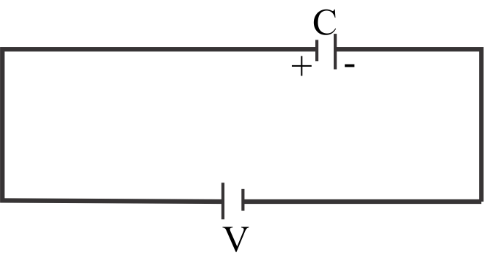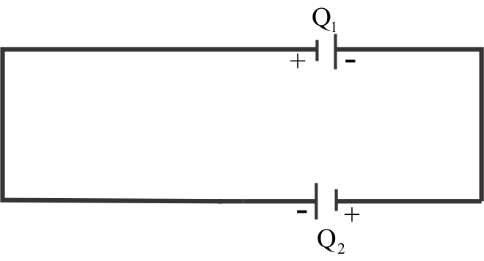
A capacitor is charged by a battery. The battery is removed and another identical uncharged capacitor is connected in parallel. The total electrostatic energy of the resulting system:
$\left( a \right)$ Increase by a factor of $2$
$\left( b \right)$ Increase by a factor of $4$
$\left( c \right)$ Decrease by a factor of $2$
$\left( d \right)$ Remains the same
Answer
207.6k+ views
Hint: Kirchhoff’s Voltage Law is that the second of his elementary laws we will use for circuit analysis. His voltage law states that for a closed-loop system series path the algebraically total of all the voltages around any closed-loop system in an exceeding circuit is adequate zero. This is often as a result of a circuit loop that could be a closed conducting path thus no energy is lost.
Complete step by step solution: Here in the question it is given that the capacitor is charged initially with the battery. For this, the diagram is shown below.


The total charge is equal to ${Q_0}$;
Therefore from the figure, we can write,
$ \Rightarrow {Q_1} + {Q_2} = {Q_0}$
Now applying KVL,
And as we know in KVL for a closed-loop system series path the algebraically total of all the voltages around any closed-loop system in an exceeding circuit is adequate zero.
Therefore,
\[ \Rightarrow \dfrac{{{Q_1}}}{C} = \dfrac{{{Q_2}}}{C} = 0\]
On further solving the equation, we can write it as;
$ \Rightarrow {Q_1} = {Q_2}$
And since ${Q_1} + {Q_2} = {Q_0}$
Therefore
$ \Rightarrow {Q_1} = {Q_2} = \dfrac{{{Q_0}}}{2}$
Since the initial electrostatic charge is,
\[ \Rightarrow {E_i} = \dfrac{1}{2}C{V^2} = \dfrac{{Q_0^2}}{{2C}}\]
Therefore, the final electrostatic charge will be
\[ \Rightarrow {E_f} = \dfrac{1}{2}C{V^2} + \dfrac{1}{2}C{V^2}\]
Now putting the values which we have calculated initially in the above equation, we get
\[ \Rightarrow \dfrac{{Q_1^2}}{{2C}} + \dfrac{{Q_2^2}}{{2C}}\]
On further solving,
\[ \Rightarrow \dfrac{{Q_0^2}}{{8C}} + \dfrac{{Q_0^2}}{{8C}}\]
Adding both the terms, we get
\[ \Rightarrow \dfrac{{Q_0^2}}{{4C}}\]
So now we will calculate the ratio of ${E_f}$and ${E_i}$
We get,
$\dfrac{{{E_f}}}{{{E_i}}} = \dfrac{{\dfrac{{Q_0^2}}{{4C}}}}{{\dfrac{{Q_0^2}}{{2C}}}}$
On solving this, we get
$\dfrac{{{E_f}}}{{{E_i}}} = \dfrac{1}{2}$
Therefore, the total electrostatic energy of the resulting system decrease by a factor $2$.
Note: The theory behind Kirchhoff’s second law is additionally called the law of conservation of voltage, and this is often notably helpful for us once managing series circuits, as series circuits conjointly act as voltage dividers and therefore the voltage divider circuit is a very important application of the many series circuits.
Complete step by step solution: Here in the question it is given that the capacitor is charged initially with the battery. For this, the diagram is shown below.


The total charge is equal to ${Q_0}$;
Therefore from the figure, we can write,
$ \Rightarrow {Q_1} + {Q_2} = {Q_0}$
Now applying KVL,
And as we know in KVL for a closed-loop system series path the algebraically total of all the voltages around any closed-loop system in an exceeding circuit is adequate zero.
Therefore,
\[ \Rightarrow \dfrac{{{Q_1}}}{C} = \dfrac{{{Q_2}}}{C} = 0\]
On further solving the equation, we can write it as;
$ \Rightarrow {Q_1} = {Q_2}$
And since ${Q_1} + {Q_2} = {Q_0}$
Therefore
$ \Rightarrow {Q_1} = {Q_2} = \dfrac{{{Q_0}}}{2}$
Since the initial electrostatic charge is,
\[ \Rightarrow {E_i} = \dfrac{1}{2}C{V^2} = \dfrac{{Q_0^2}}{{2C}}\]
Therefore, the final electrostatic charge will be
\[ \Rightarrow {E_f} = \dfrac{1}{2}C{V^2} + \dfrac{1}{2}C{V^2}\]
Now putting the values which we have calculated initially in the above equation, we get
\[ \Rightarrow \dfrac{{Q_1^2}}{{2C}} + \dfrac{{Q_2^2}}{{2C}}\]
On further solving,
\[ \Rightarrow \dfrac{{Q_0^2}}{{8C}} + \dfrac{{Q_0^2}}{{8C}}\]
Adding both the terms, we get
\[ \Rightarrow \dfrac{{Q_0^2}}{{4C}}\]
So now we will calculate the ratio of ${E_f}$and ${E_i}$
We get,
$\dfrac{{{E_f}}}{{{E_i}}} = \dfrac{{\dfrac{{Q_0^2}}{{4C}}}}{{\dfrac{{Q_0^2}}{{2C}}}}$
On solving this, we get
$\dfrac{{{E_f}}}{{{E_i}}} = \dfrac{1}{2}$
Therefore, the total electrostatic energy of the resulting system decrease by a factor $2$.
Note: The theory behind Kirchhoff’s second law is additionally called the law of conservation of voltage, and this is often notably helpful for us once managing series circuits, as series circuits conjointly act as voltage dividers and therefore the voltage divider circuit is a very important application of the many series circuits.
Recently Updated Pages
JEE Main 2026 Cutoff Percentile: Rank Vs Percentile

JEE Main 2026 Session 1 Admit Card Release Date and Direct Download Link

JEE Main Exam Pattern 2026 - NTA Paper Pattern, Marking Scheme, Total Marks

JEE Main Slot Booking 2026 NTA Exam Slot Allotment Dates and Shifts

Self Declaration Form for JEE Mains 2026 - Mandatory Details and Filling Process

JEE Main 2026 Registration- Dates, Process, Documents, and Important Details

Trending doubts
JEE Main 2026: Application Form Open, Exam Dates, Syllabus, Eligibility & Question Papers

JEE Main Correction Window 2026- Edit Form Details, Dates and Link

Atomic Structure: Definition, Models, and Examples

Equation of Trajectory in Projectile Motion: Derivation & Proof

JEE Main Marking Scheme 2026- Paper-Wise Marks Distribution and Negative Marking Details

Angle of Deviation in a Prism – Formula, Diagram & Applications

Other Pages
JEE Advanced Marks vs Ranks 2025: Understanding Category-wise Qualifying Marks and Previous Year Cut-offs

Hybridisation in Chemistry – Concept, Types & Applications

Collision: Meaning, Types & Examples in Physics

Ideal and Non-Ideal Solutions Explained for Class 12 Chemistry

Average and RMS Value in Physics: Formula, Comparison & Application

How to Convert a Galvanometer into an Ammeter or Voltmeter




